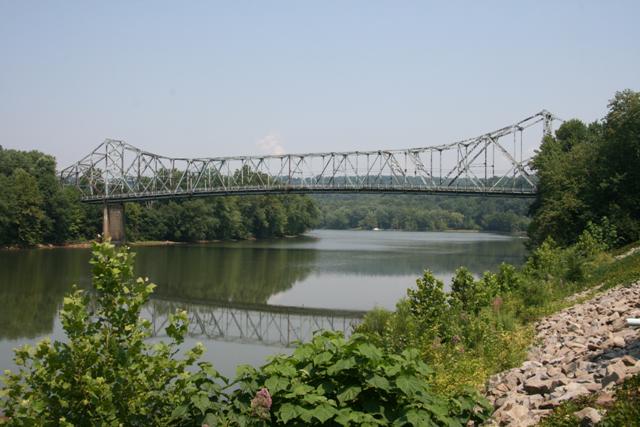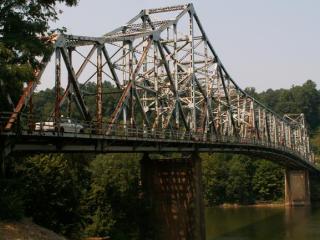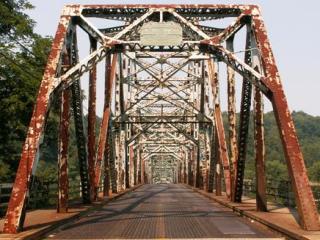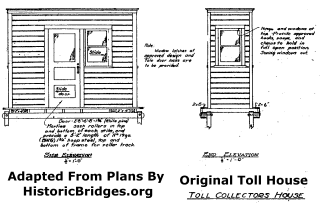We Recommend:
Bach Steel - Experts at historic truss bridge restoration.
BridgeHunter.com Phase 1 is released to the public! - Visit Now
Point Marion Bridge
Albert Gallatin Bridge

Primary Photographer(s): Nathan Holth and Rick McOmber
Bridge Documented: July 11, 2009
Point Marion: Fayette County, Pennsylvania and Greene County, Pennsylvania: United States
Metal Cantilever 20 Panel Rivet-Connected Warren Through Truss, Fixed and Approach Spans: Metal Stringer (Multi-Beam), Fixed
1930 By Builder/Contractor: Pittsburgh - Des Moines Steel Company and Engineer/Design: Harrington and Cortelyou
1976
464.0 Feet (141.4 Meters)
810.1 Feet (246.9 Meters)
19.7 Feet (6 Meters)
3 Main Span(s) and 2 Approach Span(s)
300088000600000

View Information About HSR Ratings
Bridge Documentation
This bridge no longer exists!
View Archived National Bridge Inventory Report - Has Additional Details and Evaluation
View NRHP Nomination For This Historic Bridge
View Interpretive Signage For This Historic Bridge Placed After Demolition
View Original Plans For This Historic Bridge
This Historic Bridge Was Demolished By PennDOT 9:00 AM EST November 16, 2009
The Point Marion Bridge, which is listed on the National Register of Historic Places, is the second oldest cantilever truss bridge in the entire Commonwealth of Pennsylvania. The length of the trusses excluding the stringer approach spans is 740 Feet (225.55 Meters). Only the Ambridge Bridge is older. The Point Marion Bridge is a relatively old example of a bridge type that was built for large crossings during the twentieth century. The structure type is today a historic type, since it has in nearly all cases been replaced by the cable-stayed bridge, which is the structure type built for nearly all large-size crossings in the world today. Because there are only so many large rivers in the United States, and also because the cost of a large bridge limits the number of bridges on a large river, the total number of cantilever truss bridges was never as high as other structure types. Today, these bridges are being replaced at frightening rates. The historically significant examples, which are generally those bridges that were built before 1950, are quickly becoming as rare as other older historic bridge types like the 1870s bowstring truss bridges. As such, it is imperative that surviving examples be preserved, lest one of the most complex and significant forms of bridge construction and engineering be lost forever. Although not as old as some historic bridge types like the bowstring, bridges like the Point Marion should be considered just as important, due to their scarcity. Finally, not only are cantilever truss bridges historically significant, they are aesthetically significant, and among the most impressive and beautiful of bridge types. They are truly a geometric work of art, with their infinitely complex arrangement of angles and triangles, formed from the truss web and various bracing as well. On older bridges like the Point Marion Bridge, this complex beauty is only furthered by the angles created by v-lacing and lattice present on the built-up members, chords, and bracing.

The Point Marion Bridge is of particular significance, and should receive an unusually high priority for preservation for many reasons. First and foremost, it is the second oldest example of a cantilever truss bridge in Pennsylvania. Secondly, it retains a very high degree of historic integrity, which is unusual for large bridges which often receive greater traffic, and thus more maintenance projects than smaller bridges. Even the railings are unaltered, including no modern guardrails for vehicles added. The Point Marion Bridge features a clearly defined suspended span. The suspended span is essentially a Warren through truss that is held up by tension members that are attached to the cantilever arms, which are the trusses that extend from the piers. The bridge features a large, and highly attractive plaque. This plaque is shaped like the bridge, and the name of the bridge is organized inside an abstract depiction of the bridge.
Some people are often surprised when standing on a bridge like the Point Marion Bridge and they feel relatively significant motion, (vertical oscillations) on the bridge when a heavy truck crosses. This is not an indication that the bridge is weak or dangerous, as many falsely believe. Rather, it means the bridge is doing its job and flexing. The center suspended span is not rigidly connected to the cantilever arms, indeed it is connected by tension members that feature pinned connections that allow the span to move a bit. Think of the center of the bridge like a suspension bridge... suspension bridges tend to move a lot too.
The Point Marion Bridge is an excellent candidate for preservation. A new one-way bridge could be built next to it, and the historic bridge could be restored, and a one-way couplet would be formed, eliminating the problem of a narrow roadway on the historic bridge. Alternatively, the historic bridge could be bypassed by a new two-lane bridge, and the historic bridge could be restored for non-motorized use. There is a nearby rail-trail and as such the bridge would be useful in accommodating those trail users, and would also provide a central attraction for the trail system. If used for this purpose, the bridge is wide enough that the sidewalks could be used for the trail traffic, while the highway portion of the deck could be converted into a little over-river park, with picnic tables, benches, and such. Interpretive signage could be placed, providing a little history lesson. Signs could detail the history of the bridge, its builders and steel fabricators, the connections of the steel industry to Pennsylvania's heritage, as well as the history of the Monongahela River and Point Marion. Finally, the Point Marion Bridge is also a good candidate for preservation since is a medium-length cantilever truss bridge. This means it is large enough that it represents a significant example of cantilever technology, but is not so large as to produce an overly large restoration cost.
Unsurprisingly, PennDOT does not agree with the above logical assessment that clearly shows the importance and feasibility of preservation, as well as the unique opportunities that preservation would provide. Instead, ground was broken on December 5, 2007 on a new two-lane bridge. Breaking from the progression of modern bridge design, this new bridge is supposedly going to be a modern, non-historic truss bridge. This is likely being done to satisfy Section 106 mitigation for the demolition of the historic bridge. Due to the fact that a modern bridge will not feature key elements like rivets and built-up steel beams, this new bridge cannot be considered similar. This new bridge is to be located 75 feet away from the historic bridge, meaning the historic bridge is not in the way of its replacement. Given that the Point Marion Bridge is a rare, beautiful, and historic landmark listed on the National Register of Historic Places, one would assume that this would mean the bridge is safe from demolition, and will be left standing next to its replacement. However, like all bridges that PennDOT does this with, PennDOT plans to demolish the historic Point Marion Bridge after the new bridge is completed. This action will serve no purpose other than representing a waste of taxpayer dollars that does nothing but destroy beauty and history. Even if restoration money is not available, the bridge, which is currently still capable of holding heavy trucks, would be able to stand closed to traffic with no further repairs undoubtedly for decades. Indeed, the only people who benefit from these demolitions are those who demolish the bridge and sell the steel for scrap money. These people cash in on tragedy like ambulance-chasing lawyers. Profit from historic bridge demolitions should be illegal. HistoricBridges.org asks anyone who cares for historic bridges to write to legislators requesting legislation that requires any money gained from the sale of scrap materials from a bridge listed on or eligible for the National Register of Historic Places to be placed in a special fund that is to be used toward the preservation of other historic bridges.

In regards to the new bridge PennDOT is building, particular emphasis was placed on, and money is to be spent, on including a sidewalk to accommodate rail-trail users. This is a foolish and wasteful decision since a rare and historic landmark is already in place and would be the perfect way to provide a scenic, historic, and functional crossing for non-motorized traffic. Instead, PennDOT's plan is to herd pedestrians onto a bland, mundane modern slab bridge alongside noisy trucks and cars. Clearly, PennDOT does not have the interests of non-motorized traffic in mind in its design. People who choose to walk instead of drive would appreciate the increased peace and scenery that a preserved Point Marion Bridge would provide.
It is also worth pointing out that Greene County, of which half this bridge is in, makes significant efforts to market their many preserved wooden covered bridges. The preservation of these bridges, with a simultaneous ignorance of other historic bridge types, is an insult to anyone with a knowledge of history and transportation heritage. It is important to show all aspects and periods of history, not just one little peephole. The preservation of the Point Marion Bridge would be an excellent step in the direction of showing a more complete picture of the stages of development that bridge construction underwent.
![]()
Photo Galleries and Videos: Point Marion Bridge
Original / Full Size Gallery
Original / Full Size PhotosFor the best visual immersion and full detail, or for use as a desktop background, this gallery presents selected overview and detail photos for this bridge in the original digital camera resolution. This gallery offers photos in the highest available resolution and file size in a touch-friendly popup viewer.
Alternatively, Browse Without Using Viewer
![]()
Structure Overview
Mobile Optimized PhotosA collection of overview photos that show the bridge as a whole and general areas of the bridge. This gallery features data-friendly, fast-loading photos in a touch-friendly popup viewer.
Alternatively, Browse Without Using Viewer
![]()
Structure Details
Mobile Optimized PhotosA collection of detail photos that document the parts, construction, and condition of the bridge. This gallery features data-friendly, fast-loading photos in a touch-friendly popup viewer.
Alternatively, Browse Without Using Viewer
![]()
Eastbound Crossing
Full Motion VideoStreaming video of the bridge. Also includes a higher quality downloadable video for greater clarity or offline viewing.
![]()
Demolition
Full Motion VideoDemolition of the suspended span. Video provided by PennDOT. Streaming video of the bridge. Also includes a higher quality downloadable video for greater clarity or offline viewing.
![]()
Maps and Links: Point Marion Bridge
This historic bridge has been demolished. This map is shown for reference purposes only.
Coordinates (Latitude, Longitude):
Search For Additional Bridge Listings:
Bridgehunter.com: View listed bridges within 0.5 miles (0.8 kilometers) of this bridge.
Bridgehunter.com: View listed bridges within 10 miles (16 kilometers) of this bridge.
Additional Maps:
Google Streetview (If Available)
GeoHack (Additional Links and Coordinates)
Apple Maps (Via DuckDuckGo Search)
Apple Maps (Apple devices only)
Android: Open Location In Your Map or GPS App
Flickr Gallery (Find Nearby Photos)
Wikimedia Commons (Find Nearby Photos)
Directions Via Sygic For Android
Directions Via Sygic For iOS and Android Dolphin Browser
USGS National Map (United States Only)
Historical USGS Topo Maps (United States Only)
Historic Aerials (United States Only)
CalTopo Maps (United States Only)








